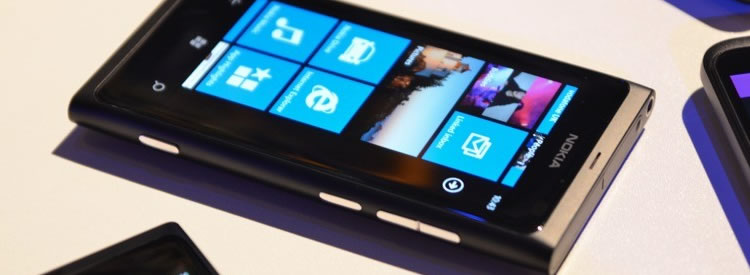Usability, Calling / Data
As alluded to earlier, software-wise every Windows Phone's software is alike. Microsoft's Metro user interface is novel and fun to use, being comprised of a tiled home page and applications that pivot to different views by swiping left or right. It's different, for sure, but every bit as intuitive as Android or iOS in my opinion.
Though I like the interface, there are still far too few options for manufacturers, carriers, or even consumers to customize a device. Sure we can set "Nokia Blue" or a handful of other colors as the accent color for tiles and links, but your background choices are limited to black or white. You can set a wallpaper for the lock screen, but not for the home screen or main menu. On top of that, the tiles offer no flexibility in sizing, though you can position them in any order you like and pin a tile for most anything (address, album, application, bookmark, etc) to the start screen. Apart from those items, though, there's little you can do to make the phone feel like your own. Microsoft will have to improve upon that.

The built-in social networking support that one finds in the People app is probably best suited to non-hardcore social networking fans. It's functional and easy to use, but it won't replace a dedicated app for some folks - though the new group support makes it wickedly easy to follow what just a particular group of people are doing on your social networks. It makes it easy to follow the antics of your real friends while ignoring those of the thousands of "friends" you otherwise follow.
I think Microsoft has done a great job with the Windows Phone virtual keyboard, but I still wish there was support for third party keyboards as an option. The ring profile and volume system in Windows Phone is a problem since video and music playback, games, and the ringer are all tied to one volume setting. At least switching the phone to vibrate mode is easy since you can change it with a tap on the phone's status area after tapping the volume control once.

Perhaps the best thing about Windows Phone on the Nokia Lumia 800 is how smooth it is. It runs on a single-core processor (1.4GHz), but the screens scroll and pan more smoothly than you'll find on any dual-core Android smartphone.
The microphone on the Nokia Lumia 800 appears to be solid since outbound call audio is very crisp and clear. Inbound audio, however, has not proven to be the phone's strong point, with results depending on the strength of the available signal. The Lumia 800 is capable of HSPA 14.4 3G data connections on the 900, 1900, and 2100MHz bands, which means it supports some parts of AT&T's network - but not all. The phone also features Wi-Fi and Bluetooth support, but doesn't support general USB mass storage mode and instead relies on Microsoft's Zune software for media transfers.

I think Windows Phone 7.5 is a great OS for messaging. I fell in love with its beautiful and slick email client that lets you combine email accounts into multiple combined inboxes, and I love the integrated conversation sorting. The Messaging app is also quite nice, and it allows you to switch between text, MMS, Windows Live, and Facebook chat on the fly - all within the same threaded view. Gmail, Exchange, Facebook, Twitter, and LinkedIn can all be used as sources for contacts and (where supported) calendar appointments. Fans of other instant messaging systems will have to seek out third party apps, though.
